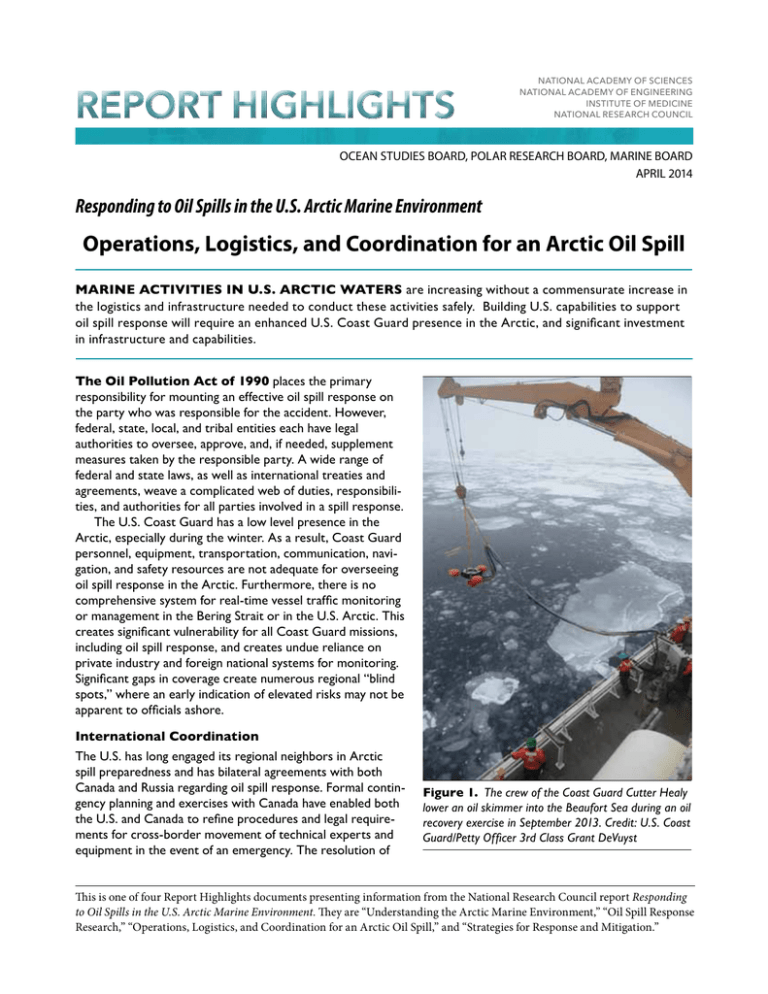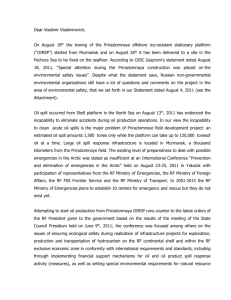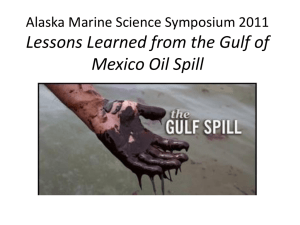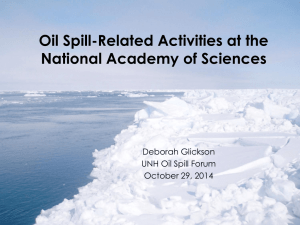REPORT HIGHLIGHTS
advertisement

REPORT HIGHLIGHTS NATIONAL ACADEMY OF SCIENCES NATIONAL ACADEMY OF ENGINEERING INSTITUTE OF MEDICINE NATIONAL RESEARCH COUNCIL OCEAN STUDIES BOARD, POLAR RESEARCH BOARD, MARINE BOARD APRIL 2014 Responding to Oil Spills in the U.S. Arctic Marine Environment Operations, Logistics, and Coordination for an Arctic Oil Spill MARINE ACTIVITIES IN U.S. ARCTIC WATERS are increasing without a commensurate increase in the logistics and infrastructure needed to conduct these activities safely. Building U.S. capabilities to support oil spill response will require an enhanced U.S. Coast Guard presence in the Arctic, and significant investment in infrastructure and capabilities. The Oil Pollution Act of 1990 places the primary responsibility for mounting an effective oil spill response on the party who was responsible for the accident. However, federal, state, local, and tribal entities each have legal authorities to oversee, approve, and, if needed, supplement measures taken by the responsible party. A wide range of federal and state laws, as well as international treaties and agreements, weave a complicated web of duties, responsibilities, and authorities for all parties involved in a spill response. The U.S. Coast Guard has a low level presence in the Arctic, especially during the winter. As a result, Coast Guard personnel, equipment, transportation, communication, navigation, and safety resources are not adequate for overseeing oil spill response in the Arctic. Furthermore, there is no comprehensive system for real-time vessel traffic monitoring or management in the Bering Strait or in the U.S. Arctic. This creates significant vulnerability for all Coast Guard missions, including oil spill response, and creates undue reliance on private industry and foreign national systems for monitoring. Significant gaps in coverage create numerous regional “blind spots,” where an early indication of elevated risks may not be apparent to officials ashore. International Coordination The U.S. has long engaged its regional neighbors in Arctic spill preparedness and has bilateral agreements with both Canada and Russia regarding oil spill response. Formal contingency planning and exercises with Canada have enabled both the U.S. and Canada to refine procedures and legal requirements for cross-border movement of technical experts and equipment in the event of an emergency. The resolution of Figure 1. The crew of the Coast Guard Cutter Healy lower an oil skimmer into the Beaufort Sea during an oil recovery exercise in September 2013. Credit: U.S. Coast Guard/Petty Officer 3rd Class Grant DeVuyst This is one of four Report Highlights documents presenting information from the National Research Council report Responding to Oil Spills in the U.S. Arctic Marine Environment. They are “Understanding the Arctic Marine Environment,” “Oil Spill Response Research,” “Operations, Logistics, and Coordination for an Arctic Oil Spill,” and “Strategies for Response and Mitigation.” anticipated response problems with Russia, including communications between command centers, coordinated planning, trans-boundary movement of people and equipment, and identification of translators, needs to be accomplished in advance of an actual event. Infrastructure The lack of infrastructure and oil spill response equipment in the U.S. Arctic (Figure 3) is a significant liability in the event of a large oil spill. Building U.S. capabilities to support oil spill response will require significant investment in physical infrastructure and human capabilities, from communications and personnel to transportation systems and traffic monitoring. Prepositioning response equipment throughout the Arctic would provide more immediate access to oil spill countermeasures. Training and Organization Local communities possess knowledge of ice conditions, ocean currents, and marine life in areas that could be affected by oil spills, yet there have been only modest efforts to integrate local knowledge into formal incident command-based responses. Flexible and scalable organization is important to develop an effective Arctic oil spill response. This can be achieved through drills, case studies, simulation, and organizational learning. To build system-wide capacity, sustained long-term training and continued resource investments are required. Inclusive and trustful communications, relationship-building, and decision-making; clear accountability; and on-going assessment and improvement are also needed. Figure 2. International coordination between the United States and its Arctic neighbors is important for effective oil spill response. Here, the U.S. Coast Guard Cutter SPAR and Canadian coast guard ship Sir Wilfrid Laurier sail side-by-side near Teller, Alaska, during a test of an oil spill response system which uses a remote controlled skimmer, submersible pump, and inflatable barge to collect oil from the surface of the water. Credit: U.S. Coast Guard Petty Officer 3rd Class Jonathan Klingenberg. Coast Guard Needs RECOMMENDATIONS ¾¾ As oil and gas, shipping, and tourism activi- ties increase, the U.S. Coast Guard will need an enhanced presence and performance capacity in the Arctic, including area-specific training, icebreaking capability, improved availability of vessels for responding to oil spills or other emergency situations, and aircraft and helicopter support facilities for the open water season and eventually year-round. Furthermore, Arctic assignments for trained and experienced personnel and tribal liaisons should be of longer duration, to take full advantage of their skills. Sustained funding will be required to increase the presence of the Coast Guard in the Arctic and to strengthen and expand their ongoing Arctic oil spill research programs. ¾¾ The U.S. Coast Guard should expedite its evalua- tion of traffic through the Bering Strait to determine if vessel traffic monitoring systems, including an internationally recognized traffic separation scheme, are warranted. If so, this should be coordinated with Russia. The Coast Guard should also consider obtaining broader satellite monitoring of Automatic Identification System (AIS) signals in the Arctic through government means or from private providers. Figure 3. Lack of infrastructure and oil spill response equipment in the U.S. Arctic could present a significant liability in the event of a large oil spill. Arctic shipping routes, the Alaska Department of Environmental Conservation’s spill response equipment depots, and villages and towns with the capacity to land passenger jets in Alaska are shown on this map. Training and Organization RECOMMENDATIONS ¾¾ The U.S. Coast Guard should expand its bilateral agreement with Russia to include Arctic spill scenarios, conduct periodic exercises to establish joint responses under Arctic conditions, and build on existing bilateral agreements with Russia and Canada to develop and exercise a joint contingency plan. ¾¾ Infrastructure to support oil spill response should be enhanced in the North Slope and Northwest Arctic Boroughs, with marine facilities for addressing response operations. The scope, scale, and location of infrastructure needs should be determined through structured decision processes, studies, and risk assessments. ¾¾ The U.S. Coast Guard and Alaska Department of Environmental Conservation should undertake the development of an oil spill training program for local entities to develop trained response teams in local villages. Industry should continue to participate in local training initiatives. Local officials and trained village response teams should be included in the coordinated decision-making and command process during a response event. Input from community experts should be actively solicited for inclusion in response planning and considered in conjunction with data derived from other sources. The Coast Guard should set this as an exercise objective in all government-led oil spill response exercises in the Arctic and should set the expectation that industry-led exercises will do the same. ¾¾ Relevant federal, state, and municipal organizations (such as the U.S. Coast Guard, National Oceanic and Atmospheric Administration, Bureau of Safety and Environmental Enforcement, Bureau of Ocean Energy Management, Alaska Department of Environmental Conservation, Alaska Department of Natural Resources, U.S. Fish and Wildlife Service, Alaska Fish and Game, North Slope Borough, and Northwest Arctic Borough), local experts, industry, and academia should undertake regularly scheduled oil spill exercises designed to test and evaluate the flexible and scalable organizational structures needed for highly reliable Arctic oil spill response. Locate additional information, including related reports, at http://dels.nas.edu/osb Read, purchase, or download a free PDF of this report at http://www.nap.edu Committee on Responding to Oil Spills in Arctic Marine Environments: Martha R. Grabowski (Chair), Le Moyne College/ Rensselaer Polytechnic Institute; Thomas Coolbaugh, ExxonMobil Research and Engineering; David F. Dickins, DF Dickins and Associates, LLC; Richard Glenn, Arctic Slope Regional Corporation; Kenneth Lee, Commonwealth Scientific and Industrial Research Organisation; William (Lee) Majors, Alaska Clean Seas; Mark D. Myers, University of Alaska, Fairbanks; Brenda L. Norcross, University of Alaska, Fairbanks; Mark Reed, SINTEF; Brian Salerno*, BIMCO; Robert Suydam, North Slope Borough; James M. Tiedje (NAS), Michigan State University; Mary-Louise Timmermans, Yale University; Peter Wadhams, Cambridge University; Deborah Glickson (Senior Program Officer), Lauren Brown (Associate Program Officer, Polar Research Board), Stacee Karras (Research Associate), Heather Chiarello (Senior Program Assistant, until April 2013), Payton Kulina (Program Assistant, from June 2013), National Research Council. *Resigned from the committee . The National Academies appointed the above committee of experts to address the specific task requested by the U.S. Arctic Research Commission; American Petroleum Institute; U.S. Coast Guard; U.S. Department of the Interior, Bureau of Ocean Energy Management and Bureau of Safety and Environmental Enforcement; Marine Mammal Commission; National Oceanic and Atmospheric Administration; Oil Spill Recovery Institute; National Academy of Sciences. The members volunteered their time for this activity; their report is peer-reviewed and the final product signed off by both the committee members and the National Academies. This report brief was prepared by the National Research Council based on the committee’s report. For more information, contact the Ocean Science Board at (202) 334-2714 or visit http://dels.nas.edu/osb. Copies of Responding to Oil Spills in the U.S. Arctic Marine Environment are available from the National Academies Press, 500 Fifth Street, NW, Washington, D.C. 20001; (800) 624-6242; www.nap.edu. Permission granted to reproduce this document in its entirety with no additions or alterations. Permission for images/figures must be obtained from their original source. © 2014 The National Academy of Sciences




